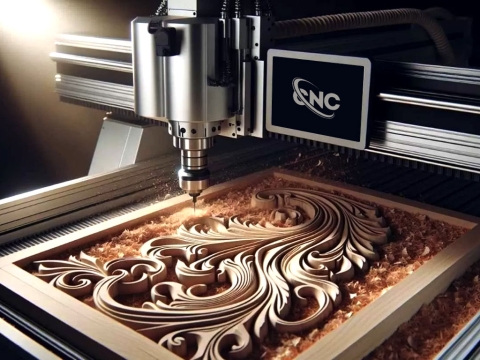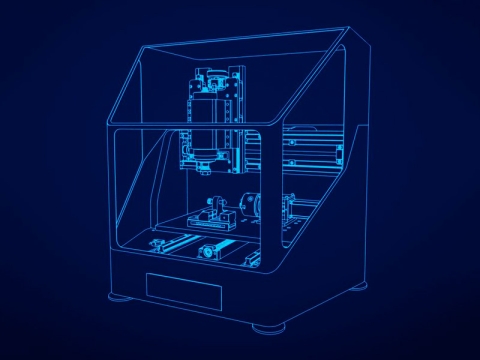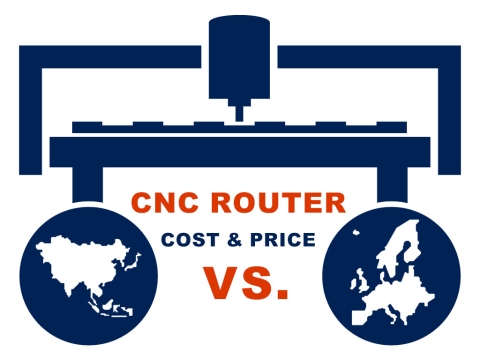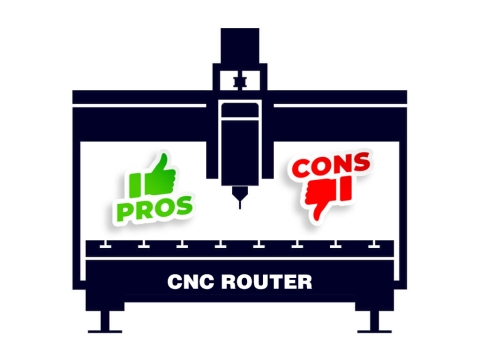Regular router bits are used for carving and cutting in CNC routers, while some special router bits can be used in CNC milling machines to mill metal molds, CNC drilling machines to drill holes, and CNC machining centers to cut wood and metal with automatic tool changer, but the standard router bits cannot be used for CNC lathes instead of turning tools.
Router Bits
What is a Router Bit?
A router bit is a tool used for flat carving, relief carving, cutting, grooving and drilling. It is fixed on the CNC router spindle with the tool holder, and moves along the tool path according to the G-code command issued by the CNC controller, and the substrate will be carved with patterns or cut into shapes.
The cutting speed of the CNC router is very important, while the router bit maker and model also affects the machining quality and efficiency. How to choose the right router bits for your CNC machine?
How Many Type of Router Bits?
At present, the most common standard router bits in the market include straight cutting bits, rabbeting bits, V-groove cutting bits, flush trimming bits, core cutting box bits, edge cutting bits, cove cutting bits, rounding-over bits, chamfer cutting bits, and specialist router bits.
A problem that must be faced when making a tool path is the selection of the router bit. The edge angle and edge width of the tool have a great influence on the machining accuracy and speed. If the edge angle and edge width of the tool are large, the cutting speed will be fast, but the resulting graphics may not be fine. If the blade angle and blade width of the tool are small, the cutting speed will be slow, but the graphics will be very fine, and the durability of the tool will be relatively poor. Therefore, the path should be grasped as much as possible, and the most suitable tool should be selected. In actual working, the relationship between machining quality and efficiency should be fully considered, and methods such as rough router bit, fine router bit and 3D router bit should be flexibly applied. Small tools should be used for fine machining, and the setting of the overlap ratio of the tools is also important. Therefore, the accurate use of the tool in the actual cutting process is the key to success.
How to Use Router Bits in a CNC machine?
Different materials use different tools. Here I will introduce you what types of router bits you should use for specific materials:
• Acrylic cutting is recommended to use a single-edged spiral router bit, which is characterized by smokeless and tasteless processing, high speed, high efficiency, no sticky chips, and truly environmentally friendly. Its special manufacturing process ensures that the acrylic will not burst with smooth surface and cutting edge. The machined surface needs to achieve a frosted effect, and it is recommended to use a double-edged three-edged spiral tool.
• MDF cutting is recommended to use a double-edged large chip removal spiral router bit. It has two high-capacity chip removal grooves and a double-edged design. Good tool balance, no blackening, no cap smoke, and long service life when processing medium and high density boards.
• Aluminum sheet cutting is recommended to use a single-edged special aluminum milling cutter. No sticking to the router bit during cutting with high speed and high efficiency.
• Precision small relief carving is recommended to use a round-bottomed carving router bit.
• Cork, MDF, virgin wood, PVC, acrylic large-scale deep relief carving is recommended to use a single-edged helical ball end router bit.
• Upper and lower burr-free cutting is recommended to use single-edged, double-edged up and down router bits.
• Metal carving is recommended to use a single-edged, double-edged straight-grooved flat-bottomed router bit.
• 3D router bit has high concentricity and sharp edge, which is used for precise 3D carving.
• High-density board and solid wood is recommended to use edge-tooth router bit.
• Multi-layer board and splint machining is recommended to use double-edged straight groove router bit.
• Lower cutter will make the upper surface no burrs, and there is no rocker during machining.
• Tungsten steel milling cutters are recommended for metal mold making, and the surface is plated with purple black and hardened titanium.
• Multi-stripe router bits is used for roughing particleboard.
• Diamond router bits are used for acrylic mirror carving.
Turning Tools
The turning tool is the most widely used single-edged tool. It is also the basis for learning and analyzing various types of tools. Turning tools are used on various lathes to process outer circles, inner holes, end faces, threads, turning grooves. According to the structure, turning tools can be divided into integral turning tools, welding turning tools, machine-clamping turning tools, indexable turning tools and forming turning tools. Among them, the application of indexable turning tools is increasingly widespread, and the proportion of turning tools is gradually increasing.
The turning tool is a single-blade tool, and there are many types due to the different shapes of the turning work piece, but the names and functions of its parts are the same. A good turning tool must have two major parts: a rigid handle and a sharp blade. The blade angle of the turning tool directly affects the turning effect. Different turning tool materials and work piece materials, and the angle of the blade are also different. The turning tool for lathe has four important angles, namely front clearance angle, side clearance angle, back bevel angle and side bevel angle.
Milling Cutters
A milling cutter is an important part of a CNC mill. A milling cutter is a rotary tool with one or more teeth to mill. During milling, each tooth intermittently cuts through the rest of the work piece. Milling cutters are used to mill planes, steps, grooves, forming surfaces, and cutting work pieces.
During a typical milling operation, the tool in a CNC milling machine moves perpendicular to its own axis, allowing it to remove excess material from the work piece around the tool's periphery. A CNC mill is a versatile machine on which a variety of machining operations can be performed. CNC mills are used to machine and manufacture parts of various shapes and sizes. A milling cutter is an essential tool for these tasks.
In order to make milling a universal machining process, there are a variety of milling cutters available in the market. These milling cutters are manufactured in a variety of sizes, shapes and materials. Some milling cutters are made of high speed steel (HSS), while others have carbide tips.
The most common milling cutters include end mills, rough mills, peripheral mills, side mills, face mills, concave mills, thread mills, ball end mills, and flying cutters.
The choice of tool diameter varies widely by product and production batch. The choice of tool diameter mainly depends on the specifications of the equipment and the machining size of the work piece.
For fine finishing, the best option is to use a ground blade. This kind of insert has better dimensional accuracy, so milling is a high positioning accuracy of the cutting edge, and better machining accuracy and surface roughness can be obtained.
For rough machining, it is better to use pressed inserts, which can reduce machining costs.
The dimensional accuracy and sharpness of the pressed blade are worse than that of the ground blade, but the edge strength of the pressed blade is better, it is resistant to impact during rough machining, and can withstand large depths of cut and large feeds.
The sharp, large rake angle inserts can be used for milling sticky materials such as stainless steel. Through the cutting action of the sharp blade, the friction between the blade and the substrate is reduced, and the chips can leave the front end of the blade faster.
Whether choosing a milling cutter on a CNC mill or an ordinary milling machine, we must comprehensively consider the material and hardness of the milling, and the specifications of the milling cutter such as blade length, blade length, blade diameter, and shank diameter. High-speed steel milling cutters are usually suitable for ordinary milling machines, while CNC mills prefer carbide tools.
Things To Consider
• The selection of the router bit requires the appropriate size of the tool collet. The collet has a cross section, the inner hole is not deformed enough to be round, the collet is worn for a long time, and the inner hole has a taper. It is easy to cause the tool handle to vibrate.
• The tool holder should match the collet and be able to enter and exit the collet compliantly. The tool holder should be able to be firmly put into the collet and tightened. If the tool collet has been used for too long, the inner hole is deformed, and a new one should be replaced immediately.
• Always check the toughness and sharpness of the tools. If you find that the tools are blunt or the edges are damaged, you should replace them immediately.
• CNC router bit requires that the thickness of the substrate cannot exceed the maximum cutting thickness of the tool, otherwise the tool will be broken or the cutting effect will be unsatisfactory.
• For carving and cutting of different materials, different tools should be selected and the cutting and carving speed should be modified reasonably.
• During the working process of the CNC router, the high-speed rotating tool is very sharp. It is necessary to pay attention that the body should not be close to the router bit as much as possible, especially to try not to wear too wide overalls. Women should bandage their hair to prevent accidents.
• The working speed of the CNC router bit should be balanced, and the cutting speed should be kept as consistent as possible.
• It is best to use professional cleaners for cleaning tools.
• When the router bit is not in use, apply butter to prevent the tool from rusting.
• Do not sharpen or change the shape of the blade by yourself.





